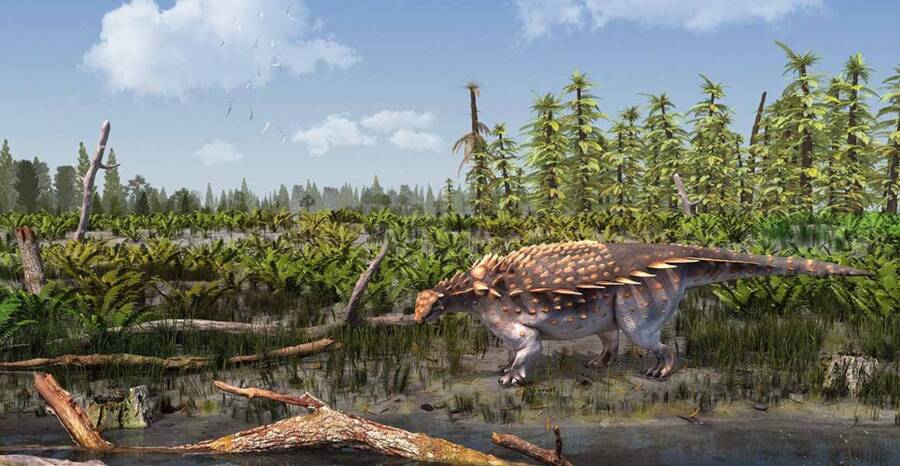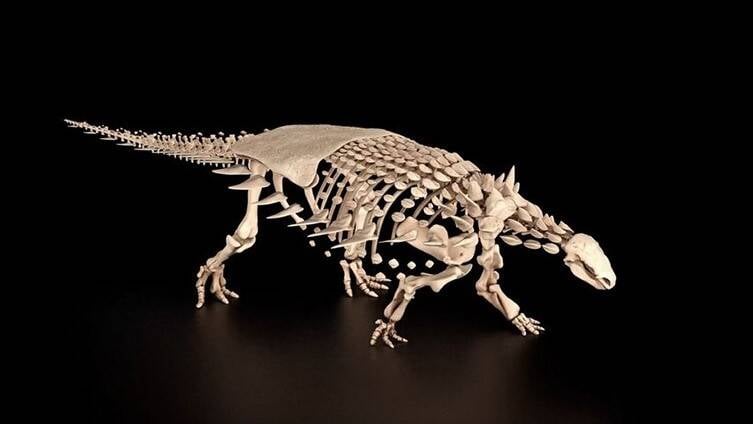Paleontologists discovered the fossils of the Vectipelta barretti, a large four-legged and armored member of the Ankylosauria dinosaur family.

Stu PondAn artistic rendition of the Vectipelta barretti, the new spiked dinosaur discovered in the United Kingdom.
Paleontologists on England’s Isle of Wight just identified the remains of a new armored dinosaur called the Vectipelta barretti.
This prehistoric creature once had blade-like spikes protruding from the sides of its body and lived in the area that is now the UK roughly 140 million years ago.
The Vectipelta barretti belongs to the Ankylosauria family — a group of large, four-legged herbivores with small heads and often armored bodies to protect them from large predators.
Paleontologists first unearthed the partial skeleton of this dinosaur in 1993 on the Isle of Wight. During the Early Cretaceous period, around 125 million years ago, this part of the world was a humid forest teeming with life.
Unexpected floods often ravaged the area, burying vegetation and animals unlucky enough to be there at the wrong time.
Because of this, the area is home to over 20 different dinosaur species, a hotspot for dinosaur fossils in the region.
A year after the dinosaur’s initial discovery, a private collector excavated the remaining pieces and kept them from the public eye. Finally, in 2021, the Dinosaur Isle Museum on the Isle of Wight obtained the specimen, allowing paleontologists to study the full set of skeletal remains for the first time.
In a study published in the Journal of Systematic Paleontology, researchers created a mock-up for how the skeleton of the Vectipelta barretti likely looked.

Stu PondA computer-generated model of the Vectipelta Barretti skeleton.
The study notes that researchers only found two other Ankylosauria dinosaur groups in the region: Polacanthus and Hylaeosaurus.
Initially, the study group believed that V. baretti was a member of the Polacanthus family given its general characteristics, but they later changed their minds.
“It [V. barretti] is actually really distinct from Polacanthus,” study co-author Susannah Maidment, a paleontologist at the Natural History Museum (NHM) in London, made in a statement published to the Natural History Museum’s website. “It has features on its neck and back vertebrae that differ, while it also has more blade-like and recurved spikes which we don’t see in the Polacanthus material that we have.”

Natural History Museum London One of the V. Baretti’s blade-like armored spikes.
Testing showed that the remains of V. baretti predate those of the oldest known Polacanthus. However, the remains are younger than the youngest Hylaeosaurus, meaning that V. baretti is likely its own species.
Evolutionary comparisons further showed that V. baretti was unlikely to be closely related to these two dinosaur groups.
According to the NMH, V. baretti is closer to other ankylosaurs found in modern-day China. This curious discovery may provide evidence for the migration of dinosaurs from Asia to Europe, but researchers need to gather more evidence before coming to any conclusions.
For now, the research team has celebrated their find by naming the dinosaur after the NMH’s dinosaur expert, Paul Barrett.
“Paul is incredibly influential in our discipline,” Maidment told the NMH. “He is incredibly high profile and has contributed an enormous amount to the field. But he’s also had an absolutely enormous influence on all of our careers, and we wanted to thank him for that. So we decided to name a small, slow-moving, spikey organism after him.”
“I’m flattered and absolutely delighted to have been recognized in this way,” Barrett told the NMH. “Not least as the first paper I ever wrote was also on an armored dinosaur in the Museum collections.”
“I’m sure that any physical resemblance is purely accidental,” he joked.
After reading about the discovery of the V. Baretti, dive into the story behind what actually killed the dinosaurs. Then, read about one of the largest predatory dinosaurs ever found, also on the Isle of Wight.





